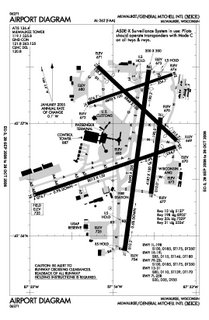Lesson 51 – More Overload
 A week ago, Sandy and I made a trip to the busy Class D Palwaukee Airport. The object of that lesson was to put me in a heavy workload situation where I had to stay ahead of the airplane to keep up. Yesterday’s lesson was more of the same but even more extreme. We flew from Waukegan to General Mitchell International Airport at Milwaukee.
A week ago, Sandy and I made a trip to the busy Class D Palwaukee Airport. The object of that lesson was to put me in a heavy workload situation where I had to stay ahead of the airplane to keep up. Yesterday’s lesson was more of the same but even more extreme. We flew from Waukegan to General Mitchell International Airport at Milwaukee.
Before we took off, I wrote down all the frequencies I thought we would need. I also had airport and taxi diagrams handy.
I called ground and told the controller we were ready to taxi for a VFR departure to the north. He cleared me to taxi to runway 23 where I called the tower for takeoff clearance. The same controller was working both ground and tower, as is usual on Sunday’s, and he cleared me to takeoff and turn on course. Three hundred feet below pattern altitude, I made my turn to the north. The controller came on and asked me what our route of flight would be. I told him we were headed north.
He came back and said, “I thought you were going west.”
I told him we were going north to
By now, we were getting close to Kenosha’s airspace so I asked for a frequency change and called the
North of the
“Cessna zero niner two radar contact, fly heading zero five zero to the lakeshore. Follow the lake shore north until off the approach end of runway three one then turn inbound and over fly runway three one at two thousand five hundred or above to the end then turn right to enter the right downwind for runway two five right.”
I can repeat it now, but yesterday I only managed to read back part of it to the controller. He had to repeat the part about following runway 31 to the end then entering g the right downwind for 25 right.
About the time I was starting my turn inbound, approach handed me off the tower. The tower controller reiterated the instruction to over fly the length of runway 31 then enter the downwind for 25R. I made the turn to downwind then had to lose a lot of altitude to get down to the traffic pattern altitude of 1700 feet. I also lost the runway in the low sun when I was on base. With
We rolled down the runway and were barely airborne when the controller directed me to turn to a heading of 200 and contact departure. I switched the radio over to the departure frequency and gave them a call. The controller came back and asked my destination. I told her we were going to
I learned a lot from the trip. It is very important to be able to multitask while flying in busy airspace. I have to write down as much of the controllers instructions as I can and not hesitate to ask for repeats when I need them. Don’t let busy controllers distract me from flying the airplane first. Use the resources I have in the plane, including passengers. Having someone along who can tune radios, help listen for radio calls and watch for traffic can greatly reduce the pilot’s workload.
Session expired
Please log in again. The login page will open in a new tab. After logging in you can close it and return to this page.
